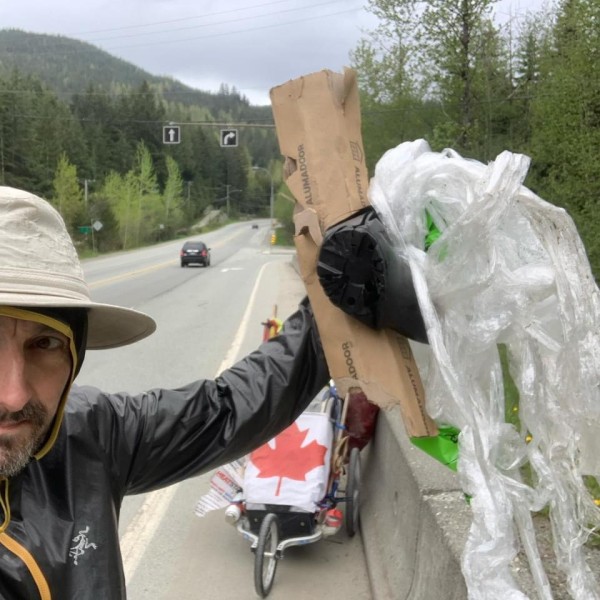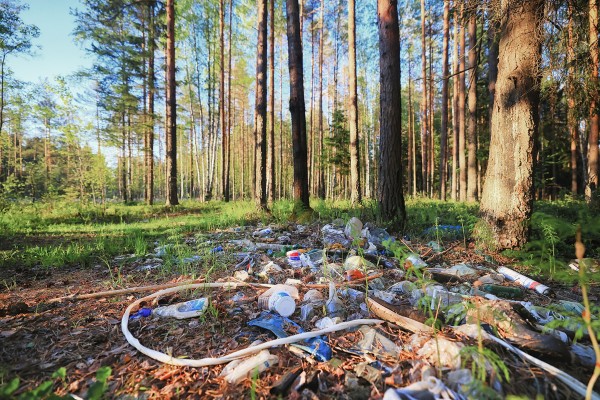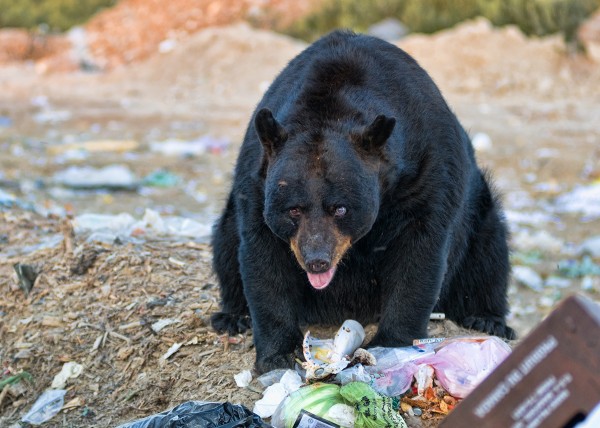By Martin Livingston

Meandering along the highways of BC, outfitted in running gear, a sun hat, high-visibility vest, and pushing a baby jogger flying the Canadian flag laden with discarded bottles and rusty cans, Andy Sward is hard to miss.
For the past decade, the 51-year-old Coquitlam catering supervisor has spent his vacation time and weekends as a one-man clean-up crew running along the country’s highways picking up litter. His journey has taken him across Canada three times collecting more than 170,000 bottles, cans and single-use cups along the way.
His goal is to pick up one million bottles, cans and cups as part of the Million Bottle Pledge.
What started as a bucket-list run across Canada in 2013 made Andy a passionate advocate for litter-free highways. “The litter at the side of the road really bothered me,” he said. “My run was about reduce, reuse and recycle, so I started picking up bottles and cans and dropping them off in the next town to be recycled.” Soon he was picking up and bagging garbage as well.
The Million Bottle Pledge has attracted converts from coast to coast to coast, who come out and run with Andy along his route pitching in to clean up their cities and towns. Along the way, Andy gives presentations in communities on the importance of keeping their local environment litter free.
His plans for a fourth cross-Canada run in 2020 were thwarted by the Covid-19 pandemic forcing him to concentrate his clean-up efforts closer to home in the Sea-to-Sky and the Sunshine Coast.
“I just fell in love with the Sea-to-Sky region,” he said. “It’s really important to keep that area clean because it’s so close to the ocean and light-weight litter like plastic and Styrofoam can easily find their way into waterways.”
An Unsightly Hazard

From bottle caps to plastic bags, cigarette butts to food wrappers, and discarded masks, litter is more than just an eyesore disrupting the aesthetic value of the country. It’s a serious environmental hazard polluting the land, soil, groundwater, waterways and marine ecosystems impacting wildlife and marine animals, as well as potentially spreading disease and infection.
“In 2010, when I was volunteering for the winter Olympics and would get on the bus from Squamish to Whistler, I was appalled by the amount of litter in the ditches at the side of the highway,” recalls Ruth Simons, President & Executive Director, of the Átl’ḵa7tsem/Howe Sound Biosphere Region Initiative Society, which recently secured a 2,187 square kilometre area extending from Squamish to the Sunshine coast as Canada’s 19th UNESCO Biosphere Region. “There was a day when there were signs along the highway stating that there was a fine for littering. You just don’t see those anymore.”
In 2010, when I was volunteering for the winter Olympics and would get on the bus from Squamish to Whistler, I was appalled by the amount of litter in the ditches at the side of the highway..."
~Ruth Simons, President & Executive Director, of the Átl’ḵa7tsem/Howe Sound Biosphere Region Initiative Society
Whether the litter is intentional or unintentional, large or small, it can drastically affect the environment for years to come. Many types of non-biodegradable litter take generations to break down if they do at all. Aluminum cans can last more than 100 years in a landfill. Over time, discarded plastics, food packaging, cigarette butts and other kinds of debris can leach toxic chemicals into the soil stunting plant growth and causing groundwater pollution which can harm animals and impact human health.
Then there’s the cost of cleaning up all this discarded trash.
Each year, municipalities spend tens of thousands of dollars to tackle the litter problem in their areas and clean up illegal dump sites. These mounting costs are then passed on to residents in the form of various levies and higher taxes.
Wildlife Threat

Animals are the innocent victims of carelessly discarded trash. Wild animals often ingest litter which can lead to sickness, internal health problems or even death. Small animals can also get their heads stuck in jars or cups that smell like food. If they can't get the container off of their head, they may suffocate or starve to death. Marine life and animals may get stuck in plastic bags or entangled in six-pack rings resulting in asphyxiation or leaving them vulnerable to predators.
When organic litter decomposes, it creates a breeding ground for multiple dangerous bacteria and viruses. Animals that come into contact with litter may transfer bacteria and viruses to humans, which can lead to outbreaks of various diseases such as cholera and typhoid. Rodents and other pests are attracted to areas where litter is abundant, increasing the risk of disease transmission. Do you want your campsite overrun with dangerous animals?
Fouling Waterways
Improperly discarded trash poses a particular threat to our aquatic environment. Torrential rains, which the west coast is known for, can carry litter on the ground into local creeks, rivers and lakes. When organic waste enters the aquatic environment, algal blooms can occur. Carpet-like layers of algae on the water body’s surface prevents oxygen from diffusing which can harm plant life and reduce the ability of fish and other aquatic life to find food. Some types of cyanobacteria blooms (sometimes called blue-green algae) are capable of producing toxins that can be harmful to humans and wildlife.

Plastics and Styrofoam are among the most problematic types of trash. After this litter is carelessly discarded, it can be picked up by winds or follow the path of water after heavy rains. Eventually, this debris can end up clogging drainage pipes and sewer grates causing flooding and major infrastructure damage.
Eventually, these plastics and other debris find their way to our oceans fouling beaches and threatening marine life. Ultraviolet radiation and weathering breaks plastic down into smaller particles called microplastics which are ingested by seabirds, fish, whales, dolphins and other marine species depleting their nutrients and blocking their stomachs and intestines. Marine species can’t break down plastic in their digestive system and usually die from internal obstruction.
Microplastics
Scientists initially assumed that plastics were destined to float in garbage patches, like the 1.6 million square kilometre Great Pacific Garbage Patch covering an area roughly the size of Ontario and Nova Scotia combined in the North Pacific Ocean. But surface surveys have accounted for only about one percent of the ocean’s estimated plastic. A recent study found that 99.8 percent of plastic that entered the ocean since 1950 had sunk below the first few hundred feet of the ocean, infiltrating the deep sea’s main food source. Scientists have found 10,000 times more microplastics on the seafloor than in contaminated surface waters.
“Accumulation of marine plastic can cause considerable harm to marine species,” said Courtney Smaha, Project Director with the Átl’ka7tsem/Howe Sound Marine Stewardship Initiative (MSI), a non-profit whose goal is to build capacity to protect the diverse economic, ecological, cultural, and social values associated with Átl’ka7tsem/Howe Sound’s ocean and freshwater. A little phytoplankton ingests a piece of microplastic, and then a fish eats that phytoplankton, then another fish eats that one, and on and on it goes up the food chain until it reaches humans. Estimates are that humans ingest the equivalent of a credit card in weight of microplastics every year.”
Ocean plastic can also absorb toxic chemicals and transport them to other marine environments with the currents and are a welcome host for alien invasive species. “When litter enters the marine environment, invasive species like muscles can hitchhike on those pieces of debris,” added Courtney. “They then get transported by different currents to areas they are not native to. They colonize those new areas and can have a devastating impact on the native ecosystem.”
'It’s really important to keep [the Sea to Sky] clean because it’s so close to the ocean and light-weight litter like plastic and Styrofoam can easily find their way into waterways.'
~Andy Sward
Marine Debris Reporting

Courtney Smaha, Átl’ka7tsem/Howe Sound Marine Stewardship Initiative
As part of its commitment to keep our aquatic environment pristine, the Marine Stewardship Initiative recently launched an online marine debris reporting system. People out on the water who observe aquatic debris can report the sighting to MSI through their online Marine Debris Reporting Form. Reported sightings help MSI develop a better understanding of what and where the marine debris is with the use of the Marine Reference Guide map so volunteers and other organizations can locate and retrieve discarded materials.
Courtney often quotes the legendary oceanographer Jacques Cousteau, who once said People Protect What They Love. “Our main objective is to get people outside. Explore what nature has to offer. See the value of our intact ecosystems and think about ways you can change your behaviours to have a positive impact on the planet.”
That means following the Leave No Trace Principles by packing out what you pack in, picking up litter during your travels, and supporting organizations that help protect the environment.
What You Can Do to Combat Litter
Report
You can report illegal waste disposal through the Province’s Report All Poachers and Polluters (RAPP) hotline. Incidents can be reported online or by calling 1-877-952-7277 (RAPP) or #7277 on the TELUS Mobility Network. Most municipalities also have illegal dumping tip lines.
Volunteer
Volunteer-led shoreline cleanups are regularly held along the west coast. To find a shoreline cleanup near you, contact ocean.org/shoreline/
Donate
Numerous non-government organizations, large and small, dedicated to preserving, protecting, and improving our environment are funded exclusively by donations and are worth supporting.
The Átl’ḵa7tsem/Howe Sound Biosphere Region Initiative Society a non-profit dedicated to biodiversity conservation, sustainable development, reconciliation, equity and inclusion in the Howe Sound region, relies largely on donations to continue its work. The Átl’ka7tsem/Howe Sound Marine Stewardship Initiative also accepts donations to continue its important work.
Another organization that welcomes donations to address our growing garbage problem is Divers for Cleaner Lakes and Oceans. Each spring and summer, volunteer divers from Divers for Cleaner Lakes and Oceans pick up trash from the bottom of Sea-to-Sky lakes and ocean sites around Vancouver. Working with local artists, this collected trash is transformed into beautiful works of art as part of an environmental art campaign Diving In: The Art of Cleaning Lakes and Oceans designed to raise awareness about the unacceptable amount of waste in our lakes and oceans.
Essential Resources
Boating & Watersports
- Boating BC - Safe Boating
- Freshwater Fisheries Society - Responsible Fishing
- BC Marine Trails - Code of Conduct
- BCSARA - Outdoor Education
- Invasive Species Council of BC - Boaters
- Whale Wise
- Squamish Windsports Society
- BC Marine Trails
- AdventureSmart Water Safety
- AdventureSmart Trip Planning App
- Vancouver Aquarium Marine Mammal Rescue Society
- Paddle BC
Motorsports and Offroading
Mountain Biking
- Mountain Bike BC - Ride Respectfully
- Outdoor Recreation Council of BC - Recreate Responsibly
- BC Parks - Backcountry Visitor Guide
- BC Gov - Know the Rules for Rec Sites & Trails
- BCSARA - Outdoor Education
- Invasive Species Council of BC - Mountain Bikers
- Pemberton Off-Road Cycling Association
- Squamish Off-Road Cycling Association
- Whistler Off-Road Cycling Association
- North Shore Mountain Bike Association
- AdventureSmart Trip Planning App
Pets
Skiing & Snowboarding
Wildlife
Related Impacts

1 Garbage And Human Waste
The improper disposal of human waste and garbage is harmful to humans, the environment, and wildlife.
- Kilograms of trash removed by Divers for Cleaner Lakes and Oceans since 2013
- 29,188
- Face masks collected by Vancouver plogger David Papineau
- 40,000

2 Human-Wildlife Conflict
People and pets getting too close to wildlife can lead to conflict, injury, and death.
- BC Parks reservations impacted by bear closures in 2024, up from 106 in 2023
- 128
- Number of black bears euthanized in BC in 2024, down from 603 in 2023
- 303

5 Trespassing & Disrespectful Use
Disrespect for sensitive ecosystems, Indigenous land, cultural sites, and private property, is hurting communities, wildlife and the environment

6 Overcrowding, Overuse & Traffic
Increased visitation is causing traffic woes, parking issues, overcrowding, and overuse in recreational areas and urban environments.